
An electric skateboard is a personal transporter based on a skateboard. The speed is usually controlled by a wireless hand-held throttle remote, or rider body weight-shifting between front of the board for forward motion and rear for braking. As for the direction of travel to the right or left, it is adjusted by tilting the board to one side or the other. The classification of electric skateboards (e.g. whether they qualify as a 'vehicle') and legality of their use on roads or pavements varies between countries.
The MotoBoard, which was gasoline-powered, was released in the summer of 1975.[2] It was banned in California in 1997 due to noise and pollution.[3][4]
Louie Finkle of Seal Beach, California is often cited as an originator of the modern electric skateboard, offering his first wireless electric skateboard in 1997[2][5] and a patent filed in April 1999,[6] however it was not until the 2004–2006 that electric motors and batteries were available with sufficient torque and efficiency to power boards effectively.[5]
In 2012, ZBoard, raised nearly 30 times their target for a balance controlled electric skateboard on Kickstarter, which was well received at the Consumer Electronics Show in Las Vegas in January 2013.[7][8] Their 2015 campaign on Indiegogo was 86 time over-subscribed, raising $1 million.[9]
There are multiple variations of electric skateboards and longboards, but 5 main types stand out:

The electric skateboard was originally designed for local transport, but later diversified for multiple uses, longer distance travel and off-road use.
The basic design of an electric skateboard consists of an electric motor (out-runner or hub), batteries, speed controller (often the specially designed VESC), and a wireless throttle on top of a regular skateboard, longboard or other variant (e.g. penny board, mountain board).
Traction is typically provided by one or more of the following:
Electric skateboards are able to travel at high speeds, as well as go off-road. Stability is determined by some key deck features:
All electric skateboards need an electronic speed controller (ESC) in order to vary the speed of the motor for accelerating or braking. Originally, hobbyists would typically use ESCs from radio-controlled model cars, but the rise in popularity and interest in building electric skateboards created demand for bespoke and more sophisticated ESCs. The VESC (Variable Electronic Speed Controller) may include motor and battery protection, regenerative braking, programming options e.g. acceleration and deceleration curves, and other advanced features.
Trucks are important and extremely durable parts that are mounted under the surface of the electric skateboard. They are part of a T-shaped metal body under the two ends of the skateboard. There are several types of trucks and truck systems, but the most commonly used are:
TKP (traditional king-pin) - usually found in skateboards.
RKP (reversed king-pin) - more stable and better for faster speeds, but with limited turning circle.
DKP (double king-pin) - more nimble and better turning circle but more unstable at higher speeds.
Channel trucks (also knows as C-trucks or Chamber trucks) - wider, more complex trucks most commonly used for off-road applications.
3-link trucks - most commonly used in racing applications.
There are several types of drivetrain for different uses, but four main types stand out:
Hub drive, using the wheel hub motor, is a system where the motor is inside the wheel and the motion is directly translated to the wheel. It is the most compact, lightweight, silent and efficient type of drivetrain but has less torque, is less comfortable to drive and the tire choices are usually limited. The motors are also more exposed to shocks, vibrations and water splashes.
Direct drive is similar to hub drive but the motors sit outside the wheel, inwards towards the truck, and are integrated in the truck assembly. The main advantage to hub drive is the flexibility in wheel and tire choice. The motor also is able to cool better, but in this case the motors are the most exposed to the elements, sitting as low to the ground as the difference between the motor radius and the wheel radius. These types of configurations are more oriented to street boards.
Belt drive is one of the most popular systems. It connects the motors and wheels via pulleys and belts. The pulleys offer flexibility for different gear ratios and the belts (usually HTD 5M type) are easy to replace and maintain. This system also offers the most flexibility in the positioning of the motors in relation to the truck, either under the board or in the back of the board. Belt drive essentially takes advantage of the high-revving electric motor, offering better acceleration and breaking for the same amount of power as hub/direct drive systems.
Gear drive is a system that connects the motors and wheels via toothed gears. These can be either enclosed or open. The enclosed variant of gear drive offers the same advantages as belt drive for less (almost no) maintenance, and is better suited for off-roading or environments with lots of debris (pebbles/rocks/twigs/grass) which could damage the belts. Disadvantages to belt drive are the added weight of the enclosure and the fixed gear ratio which can't be changed as easily.
Typical retail boards such as those from Evolve and Boosted are able to reach top speeds of around 20-25 mph (32-40 km/h) on their fastest modes, while specialist and hobbyist boards can be built with very powerful motors for top speeds of 50 mph (80 km/h) and beyond.[10] Braking is typically implemented as Dynamic braking or regenerative braking from the rear wheels only and the stopping distance can vary widely between motors and wheels/tires.
There have been several fatal accidents involving electric skateboards[11][12] and many accounts of hospital visits. Personal protective equipment including helmet, knee, elbow and wrist pads are recommended for high speed riding.